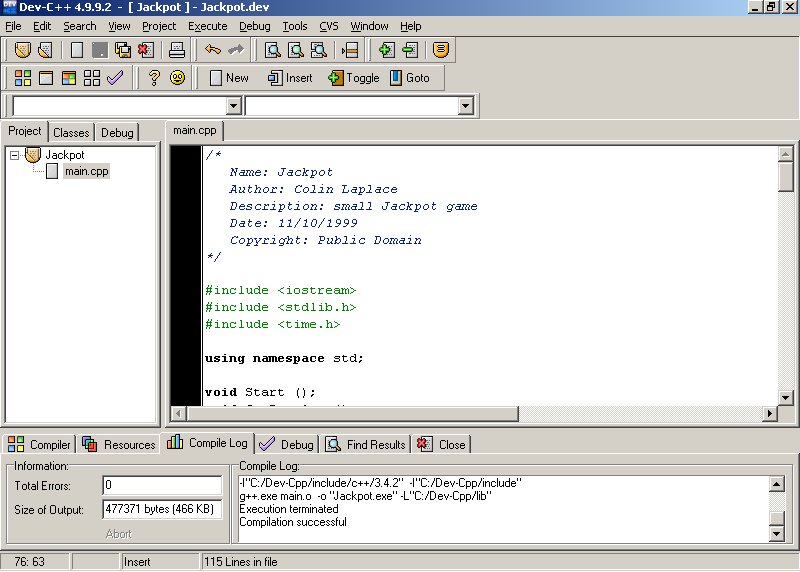Textcolor En Dev C%2b%2b
- C Marco dinamico con Textcolor. Textcolor de linea con el windows.h que permitira escribir el color en una sola linea Nos quedaria asi: void t(int n).
- VISTEN MI PAGINA DONDE ENCONTRARAN MUCHOS DATOS IMPORTANTES http://www.facebook.com/ProgramaEnDevC.
- HOLA: ESTOY PROGRAMANDO EN DEV C Y TENGO UN CODIGO EL CUAL SU FUNCION PRINCIPAL DEBE SIMULAR LA RECOLECCION DE BASURA HASTA TERMNAR Y AVISAR QUE HAYA FINALIZADO. AL CORRERLO ME MARCA 2 WARNING, NINGUN ERROR Y POR LO TANTO NO SE COMPILA. ME URGE, ESPERO ME PUEDAN AYUDAR A DECIRME CUAL ES EL ERROR. EL CODIGO ES EL SIGUIENTE: #include #include #include #include.
Saludos, utilizo el Borland C 3.1 para windows, ya he probado los comandos textcolor etc y funcionan pero en un compilador para DOS pero cuando aplico esos comandos en el editor que mencione al comienzo no me funciona esa es mi duda.
-->The #define creates a macro, which is the association of an identifier or parameterized identifier with a token string. After the macro is defined, the compiler can substitute the token string for each occurrence of the identifier in the source file.
Syntax
#defineidentifiertoken-stringopt
#defineidentifier(identifieropt, .. ,identifieropt)token-stringopt
Remarks
The #define directive causes the compiler to substitute token-string for each occurrence of identifier in the source file. The identifier is replaced only when it forms a token. That is, identifier is not replaced if it appears in a comment, in a string, or as part of a longer identifier. For more information, see Tokens.
The token-string argument consists of a series of tokens, such as keywords, constants, or complete statements. One or more white-space characters must separate token-string from identifier. This white space is not considered part of the substituted text, nor is any white space that follows the last token of the text.
A #define without a token-string removes occurrences of identifier from the source file. The identifier remains defined and can be tested by using the #if defined and #ifdef directives.
The second syntax form defines a function-like macro with parameters. This form accepts an optional list of parameters that must appear in parentheses. After the macro is defined, each subsequent occurrence of identifier( identifieropt, .., identifieropt ) is replaced with a version of the token-string argument that has actual arguments substituted for formal parameters.
Formal parameter names appear in token-string to mark the locations where actual values are substituted. Each parameter name can appear multiple times in token-string, and the names can appear in any order. The number of arguments in the call must match the number of parameters in the macro definition. Liberal use of parentheses guarantees that complex actual arguments are interpreted correctly.
The formal parameters in the list are separated by commas. Each name in the list must be unique, and the list must be enclosed in parentheses. No spaces can separate identifier and the opening parenthesis. Use line concatenation — place a backslash () immediately before the newline character — for long directives on multiple source lines. The scope of a formal parameter name extends to the new line that ends token-string.
When a macro has been defined in the second syntax form, subsequent textual instances followed by an argument list indicate a macro call. The actual arguments that follows an instance of identifier in the source file are matched to the corresponding formal parameters in the macro definition. Each formal parameter in token-string that is not preceded by a stringizing (#), charizing (#@), or token-pasting (##) operator, or not followed by a ## operator, is replaced by the corresponding actual argument. Any macros in the actual argument are expanded before the directive replaces the formal parameter. (The operators are described in Preprocessor operators.)
The following examples of macros with arguments illustrate the second form of the #define syntax:
Arguments with side effects sometimes cause macros to produce unexpected results. A given formal parameter may appear more than one time in token-string. If that formal parameter is replaced by an expression with side effects, the expression, with its side effects, may be evaluated more than one time. (See the examples under Token-Pasting Operator (##).)
The #undef directive causes an identifier's preprocessor definition to be forgotten. See The #undef Directive for more information.
If the name of the macro being defined occurs in token-string (even as a result of another macro expansion), it is not expanded.
A second #define for a macro with the same name generates a warning unless the second token sequence is identical to the first.
Microsoft Specific
Microsoft C/C++ lets you redefine a macro if the new definition is syntactically identical to the original definition. In other words, the two definitions can have different parameter names. This behavior differs from ANSI C, which requires that the two definitions be lexically identical.
For example, the following two macros are identical except for the parameter names. ANSI C does not allow such a redefinition, but Microsoft C/C++ compiles it without error.
On the other hand, the following two macros are not identical and will generate a warning in Microsoft C/C++.
END Microsoft Specific
This example illustrates the #define directive:

The first statement defines the identifier WIDTH as the integer constant 80 and defines LENGTH in terms of WIDTH and the integer constant 10. Fifa 19 apk obb download for android. Each occurrence of LENGTH is replaced by (WIDTH + 10). In turn, each occurrence of WIDTH + 10 is replaced by the expression (80 + 10). The parentheses around WIDTH + 10 are important because they control the interpretation in statements such as the following:

After the preprocessing stage the statement becomes:
which evaluates to 1800. Without parentheses, the result is:
which evaluates to 280.
Microsoft Specific
Dev C++ Cnet
Defining macros and constants with the /D compiler option has the same effect as using a #define preprocessing directive at the start of your file. Up to 30 macros can be defined by using the /D option.
Textcolor En Dev C++ Download
END Microsoft Specific